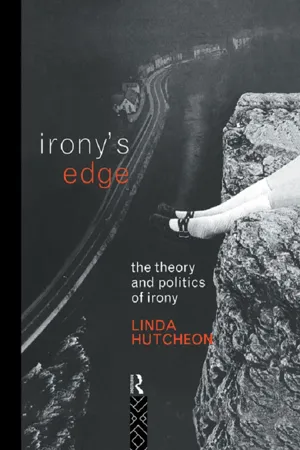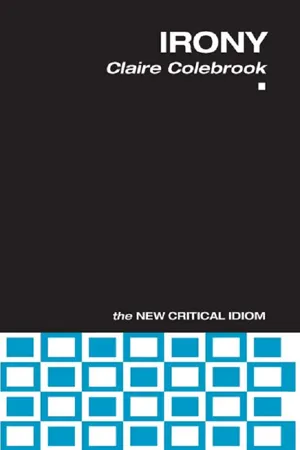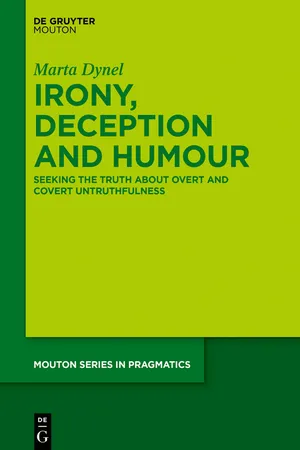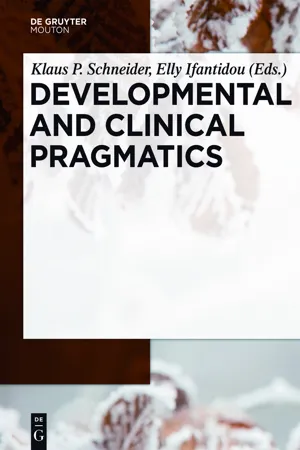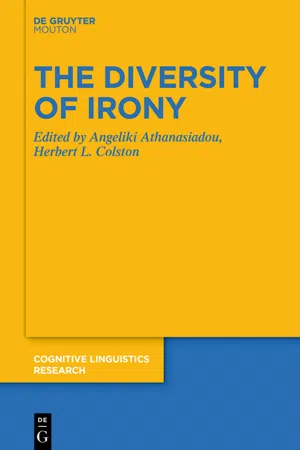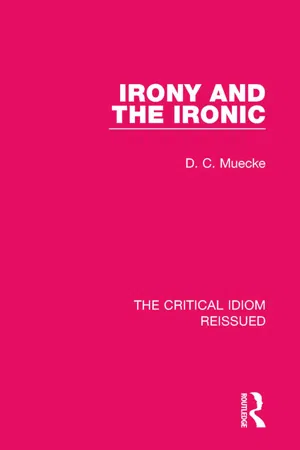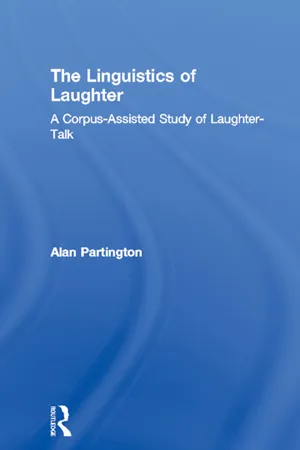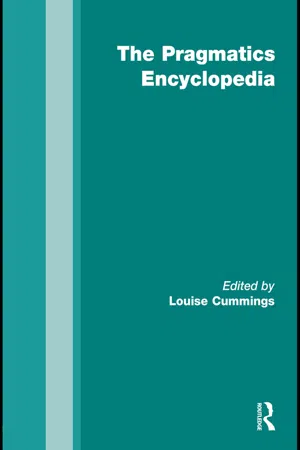Languages & Linguistics
Irony English Language
Irony in the English language refers to the use of words to convey a meaning that is the opposite of their literal interpretation, often for humorous or sarcastic effect. It involves a discrepancy between what is said and what is meant, adding depth and complexity to communication. English language learners often find irony challenging to understand due to its nuanced and context-dependent nature.
Written by Perlego with AI-assistance
Related key terms
9 Key excerpts on "Irony English Language"
- eBook - ePub
Irony's Edge
The Theory and Politics of Irony
- Linda Hutcheon(Author)
- 2003(Publication Date)
- Routledge(Publisher)
And it happens in discourse, in usage, in the dynamic space of the interaction of text, context, and interpreter (and, sometimes, though not always, intending ironist). As a response to the extensive literature—in many different fields, from linguistics to psychology, from rhetoric to literary criticism—that sees irony as a straightforward semantic inversion (antiphrasis—or saying one thing and meaning its opposite) and thus as a static rhetorical tool to be used, this chapter expands on the suggestion made earlier in this book that irony is, instead, a communicative process. It is in this framework, then, that I would argue that ironic meaning possesses three major semantic characteristics: it is relational, inclusive and differential. Irony is a relational strategy in the sense that it operates not only between meanings (said, unsaid) but between people (ironists, interpreters, targets). Ironic meaning comes into being as the consequence of a relationship, a dynamic, performative bringing together of different meaning-makers, but also of different meanings, first, in order to create something new and, then, as Chapter 2 explored, to endow it with the critical edge of judgment. As noted, that Greek eiron, from whom irony got its name, was a dissembler, a pretender, and that notion of pretense figures frequently in “performative” theories of irony (Koestler 1964: 73–4; and especially Clark and Gerrig 1984: 121), humor (Douglas 1975), and figurative language, in general. In fact, it seems that children have to learn about pretense in order to understand irony (Winner 1988). The social dimension of this relational aspect of irony is the subject of the next chapter on discursive communities and their role in the enabling and comprehending of irony - Before going on to look at the complexities of literary irony in the following chapters, we can consider the ways in which we use the concept of irony in everyday and non-literary contexts. There are two broad uses in everyday parlance. The first relates to cosmic irony and has little to do with the play of language or figural speech. A Wimbledon commentator may say, ‘Ironically, it was the year that he was given a wild-card entry, and not as a seeded player, that the Croatian won the title.’ The irony here refers, like linguistic irony, to a doubleness of sense or meaning. It is as though there is the course of human events and intentions, involving our awarding of rankings and expectations, that exists alongside another order of fate beyond our predictions. This is an irony of situation, or an irony of existence; it is as though human life and its understanding of the world is undercut by some other meaning or design beyond our powers. It is this form of irony that covers everything from statements such as, ‘Ironically, Australians are spending more than ever on weight-loss formulas while becoming increasingly obese’, to observations like, ‘The film ends ironically, with the music of the young and hopeful cellist played as we see her crippled and wasted body.’ In such cases, the word irony refers to the limits of human meaning; we do not see the effects of what we do, the outcomes of our actions, or the forces that exceed our choices. Such irony is cosmic irony, or the irony of fate.Related to cosmic irony, or the way the word ‘irony’ covers twists of fate in everyday life, is the more literary concept of dramatic or tragic irony. This is most intense when the audience knows what will happen, so that a character can be viewed from an almost God-like position where we see her at the mercy of the plot or destiny (Sedgwick 1935). If irony is taken in its broadest sense as a doubleness of meaning, where what is said is limited or undercut by what is implied, then we can start to include ironies that are not rhetorical, that have little to do with speech or language. Such ironies were not labelled as ironies until the nineteenth century (Thirlwall 1833, 490), but it is frequently argued that even ancient texts display this mode of irony. Tragic irony is exemplified in ancient drama and is intensified by the fact that most of the plots were mythic. The audience watched a drama unfold, already knowing its destined outcome. There was already a sense of irony or mourning in the predetermined plot, as though the drama could only unfold an already given destiny, as though the time when human action could be open and determining was already lost. In Sophocles' Oedipus the King
- eBook - ePub
- Marta Dynel(Author)
- 2018(Publication Date)
- De Gruyter Mouton(Publisher)
House do not include the vocalic features or facial expressions, presenting the bare form of the characters’ utterances. This aligns with Grice’s thought, for he expresses his doubt “whether the suggested [by a critic] vehicle of signification, the ironical tone, exists as a specific tone”, suggesting that irony may involve “a contemptuous or amused tone” (Grice 1989b [1978]: 54), which is not to be seen as a defining factor, for either kind of tone may communicate something different from irony.According to a well-entrenched standard definition, which has become popular folk wisdom, irony is a trope that communicates a meaning opposite/contrary to the literal meaning of an utterance. The traditional understanding of irony is then premised on meaning inversion (Haiman 1998), insofar as one meaning is stated and a different, typically antithetical, meaning is implicitly communicated. A vast majority of authors (e.g. Clark and Gerrig 1984; Kotthoff 2003; Partington 2006, 2007) do take as their point of departure the duality between the words uttered (sometimes referred to as the dictum ) from which the speaker dissociates himself/herself and what is meant (sometimes called the implicatum ). On the whole, this duality can be regarded as being based on opposition, reversal , inversion, negation of meaning or contradiction between what is uttered and what is (antithetically) meant. These terms tend to be used almost interchangeably with reference to the general mechanism underlying irony (see e.g. Holdcroft 1983; Haverkate 1990; Partington 2006, 2007; Camp 2012; Kapogianni 2016a, 2016b), which will become evident in the course of this chapter as various quotations and terms are presented. The multiple labels seem to be brought together in the literature on irony, even though they stand for different notions in semantics (see Davies 2013 for an overview). It will be shown here that meaning opposition , in tandem with the operation of meaning reversal - eBook - ePub
- Klaus P. Schneider, Elly Ifantidou, Klaus P. Schneider, Elly Ifantidou(Authors)
- 2020(Publication Date)
- De Gruyter Mouton(Publisher)
Irony in Language and Thought: A Cognitive Science Reader, 57-95. Hillsdale, NJ: Lawrence Erlbaum.)Langdon, Robyn, Martin Davies and Max Coltheart 2002 Understanding minds and understanding communicated meanings in schizophrenia. Mind and Language 17: 68-104.Laval, Virginie and Alain Bert-Erboul 2005 French-speaking children’s understanding of sarcasm: The role of intonation and context. Journal of Speech, Language, and Hearing Research 48: 610-620.Leech, Geoffrey 1983 Principles of Pragmatics. London: LongmanLeggitt, John and Raymond Gibbs 2000 Emotional reactions to verbal irony. Discourse Processes 29: 1-24.MacKay, Gilbert and Adrienne Shaw 2004 A comparative study of figurative language in children with autistic spectrum disorders. Child Language, Teaching and Therapy 20: 13-32.McDonald, Skye 2000 Neuropsychological studies of sarcasm. Metaphor and Symbol 15: 85-98. (Reprinted in: Raymond Gibbs and Herbert Colston (eds.). 2007. Irony in Language and Thought: A Cognitive Science Reader, 217-230. Hillsdale, NJ: Lawrence Erlbaum.)Milosky, Linda and Janet Ford 1997 The role of prosody in children’s inferences of ironic intent. Discourse Processes 23: 47-61.Muecke, Douglas 1969 The Compass of Irony. London: Methuen.Nakassis, Constantine and Jesse Snedeker 2002 Beyond sarcasm: Intonation and context as relational cues in children’s recognition of irony. In: Barbora Skarabela, Sarah Fish and Anna H.-J. Do (eds.), Proceedings of the Twenty-Sixth Boston University Conference on Language Development - eBook - ePub
- Angeliki Athanasiadou, Herbert L. Colston, Angeliki Athanasiadou, Herbert L. Colston(Authors)
- 2020(Publication Date)
- De Gruyter Mouton(Publisher)
jWichiarajote, Weerayut. 1973. The Theory of Affiliative Society. Bangkok: College of Education, Prasanmitr. a , bWilson, Deirdre. 2017. Irony, hyperbole, jokes and banter. In Formal Models in the Study of Language (pp. 201–219). Springer: Cham. →Wilson, Deirdre, & Sperber, Dan. 2012. Explaining irony. In Dirdre Wilson and Dan Sperber (Eds.) Meaning and Relevance (pp. 123–145). Cambridge University Press: Cambridge. →Yao, Jun, Song, Jie, & Singh, Michael. 2013. The ironical Chinese bei-construction and its accessibility to English speakers. Journal of Pragmatics, 55, 195–209. →Yu, Ning. 2001. What does our face mean to us? Pragmatics and Cognition, 9, 1–36. →Yu, Ning. 2008. Metaphor from body and culture. The Cambridge handbook of metaphor and thought, 247–261. →Yu, Ning. 2008b. The Chinese heart as the central faculty of cognition. Culture, body, and language: Conceptualizations of internal body organs across cultures and languages, 7, 131. →Yus, Francisco. 2016. Propositional attitude, affective attitude and irony comprehension. Pragmatics & Cognition, 23(1), 92–116. a , b , cEngland is an appendix; Corrupt officials are like hairs on a nation’s arm: Sarcasm, irony and self-irony in figurative political discourse
Andreas MusolffUniversity of East AngliaSing Tsun Derek WongUniversity of OxfordAbstract
In political discourse, metaphor production/use can serve to achieve irony and sarcasm, e.g. ridiculing (Brexit: the kind of divorce that involves the police), (apparent) self-effacement (I am the toenail of the body politic), or devastating critique (the heart of Europe is rotten). Can such sarcastic or ironical effects also be observed in responses to metaphor interpretation tasks? This paper looks at comprehension responses for the metaphor nation-as-body that include critical, ironical or sarcastic comments on the perceived ‘health’ or ‘character traits’ of the nation in question (e.g. England is a body with feet designed for queuing; My nation have [sic] a mad mind - eBook - ePub
- D. C. Muecke(Author)
- 2017(Publication Date)
- Routledge(Publisher)
4The practice of ironyVerbal Irony
In this final chapter I shall look, selectively, at irony in action, and in this section at Instrumental Ironies in which language is the instrument. As we shall see, it is not always possible to distinguish Instrumental Irony from the presentation of Observable Irony, but in general the distinction is clear: in Instrumental Irony the ironist says something in order to have it rejected as false, mal à propos, one-sided, etc.; in presenting an Observable Irony the ironist presents something ironic – a situation, a sequence of events, a character, a belief, etc. – that exists or is to be thought of as existing independently of the presentation.A rhetorician dogged enough could probably identify as many ways of being ironical as there are ways of using words. I shall confine myself to the commoner varieties of Verbal Irony, in a great many of which the basic technique is either that of ‘going along with’ the ironic butt and placing him in high relief or that of depreciating oneself, which is the countersinking or intaglio method.The simplest form of ‘high-relief verbal irony is the antiphrastic praise for blame, for example the ‘Congratulations!’ we offer to the ‘smart Alec’ who has let the side down. This can be elaborated in a number of directions. Probably the best known instance of ironic agreement in English literature is in Chaucer’s presentation of the worldly monk: - eBook - ePub
The Linguistics of Laughter
A Corpus-Assisted Study of Laughter-Talk
- Alan Partington(Author)
- 2006(Publication Date)
- Routledge(Publisher)
3 Moreover, irony is often used with a moral or moralistic purpose — to pass judgement on someone or something — and thus the reversal is from proper to improper (to point out the wrongfulness of the latter: consider Barbe's Fireman Alan example, or the betrayal script of many ironies, see Appendix 3), a mechanism we saw was also the basis of a vast array of joke types (although whether jokes also have a moral purpose is a monumental moot point). We have also noted how much of modern linguistic thinking considers the evaluation function to be extremely pervasive and central to language use, to which we might add, to all human cognition.Moreover, it is this shared dependence on the sudden reversal ploy which explains why irony and humour have in common the element of surprise. In espousing evaluation reversal plus hyperbole as the main ingredients of irony we begin to comprehend why it is so popular. It enables speakers/writers to be — or to project themselves as — interesting and dramatic by springing a surprise upon the hearer/reader. Irony allows one to be both suspenseful and sententious. It says: Someone (you — me — a third party — the world) evaluated things in such a way. Let me tell you this: they were really in quite a different way altogether.6.2.10 ‘Implicit’ irony
Explicit irony seems rarely to be linked to laughter-talk. However, we can now turn our attention to implicit irony, that is, irony which is not signalled by explicit lexical irony markers of the type we have been studying, and this kind of irony frequently is. We have already seen how often the word collocates with items from the semantic sets of laughter, wit and humour. Moreover, Kotthoff demonstrates how often ironic comments are followed by laughter in both conversation and more structured television debates. This kind of irony —the kind normally intended when talking of verbal irony — is also implicit in that only one of the narratives is present in the text (the dictum), whilst the other (the implication) remains unspoken and has to be reconstructed by the audience.As we have already noted, in almost all studies of implicit irony, episodes are taken for granted as being ironic for no other reason than that the author feels them to be so. Here we have already defined irony, through examination of the use of the term in authentic discourse, as involving evaluation reversal, and it is therefore contended that candidate sites of implicit irony can be identified with some degree of objectivity in interactive discourse by localizing laughter episodes where speakers employ some form of reversal. These episodes, as we saw in section 6.2.5, might well be accompanied and signalled by some kind of lexical or grammatical intensifier, some of which can be sought using the concordancer (for instance, -ly intensifying adverbs such as really or -est - eBook - ePub
Characterising Irony
A Systematic Approach to Literary and Linguistic Texts
- Steven Pattison(Author)
- 2022(Publication Date)
- Routledge(Publisher)
Furthermore, co-text, which is defined by Wales (2011, p. 93) as “the verbal or linguistic context as distinct from situational context”, also has relevance for the interpretation of some irony candidates, especially where there are collocational clashes and sudden shifts from a formal to informal register and vice versa (for an interesting example and explanation of this, see Booth, 1974, p. 68). According to my Contextual Compatibility Attribute, ironies are characterised by a conflict, incompatibility, or inconsistency between what is said and the context. Moreover, I hypothesised that in its prototypical instantiation, the Contextual Compatibility Attribute would involve an opposition between what is said and the context. Below I consider one definition and two possible frameworks for dealing with the interaction between text and context. General issues related to context The role of context is addressed in a number of papers on irony (e.g. Gibbs 2000 ; Katz, 2000 ; Bryant and Fox Tree, 2002 : Kreuz, 2000 ; Giora and Fein, 1999 ; Kihara, 2005). The conclusion reached by Bryant and Fox Tree (2002) is that contextual information and acoustic information are used to a significant extent when inferring ironic intent. Along with other researchers (e.g. Colston and Gibbs 2002), Bryant and Fox Tree refer to an irony-biasing context. However, they do not clearly define what they mean by irony-biasing context, nor do they provide an explicit example of it or specify which elements of context have the greatest biasing effect. Colston and Gibbs (2002) observe that longer contexts help to create ironic situations, but they do not elaborate on exactly how or why this is so. Objecting to the tendency of many academic studies to rely on constructed contexts, Clift (1999) uses naturally occurring examples in her work on irony. This objection is worth paying attention to - eBook - ePub
- Louise Cummings(Author)
- 2010(Publication Date)
- Routledge(Publisher)
cluster of contextual factors, including their relative weight, might shed further light on the nature of irony interpretation.RACHEL GIORASee also : Autism spectrum disorders ; clinical pragmatics ; conventionality ; development, pragmatic ; experimental pragmatics ; explicit/implicit distinction ; humour ; inference ; inferential comprehension ; neuropragmatics ; pragmatic language impairment ; right-hemisphere damage and pragmatics ; schizophrenic language ; theory of mind ; traumatic brain injury and discourseSuggestions for further reading
Barbe, K. (1995) Irony in Context , Amsterdam: John Benjamins.Gibbs, R.W. Jr and Colston, H.L. (eds) (2007) Irony in Language and Thought: A Cognitive Science Reader , New York and London: Lawrence Erlbaum Associates.Martin, A.R. (2007) The Psychology of Humor: An Integrative Approach
Index pages curate the most relevant extracts from our library of academic textbooks. They’ve been created using an in-house natural language model (NLM), each adding context and meaning to key research topics.
